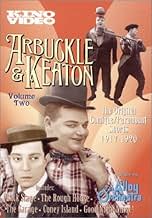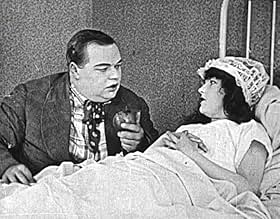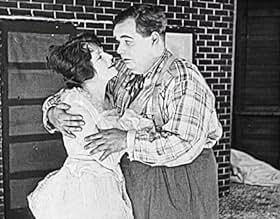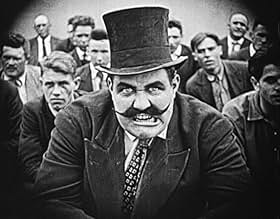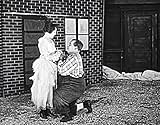Füge eine Handlung in deiner Sprache hinzuWorking their fingers to the bone to prepare the set for an upcoming performance, the enthusiastic stagehands, Roscoe and Buster, find themselves on stage when the cast quits. However, is wi... Alles lesenWorking their fingers to the bone to prepare the set for an upcoming performance, the enthusiastic stagehands, Roscoe and Buster, find themselves on stage when the cast quits. However, is will alone enough to earn a big round of applause?Working their fingers to the bone to prepare the set for an upcoming performance, the enthusiastic stagehands, Roscoe and Buster, find themselves on stage when the cast quits. However, is will alone enough to earn a big round of applause?
- Regie
- Drehbuch
- Hauptbesetzung
Empfohlene Bewertungen
The setting, with Fatty and Buster working "Back Stage" for a vaudeville show, lends itself well to humor and variety, and this setting is quite interesting in its own right. If you watch closely, you'll also notice a number of gags used here that Keaton later refined and used to even greater effect later in some of his own short features.
There are several good sequences, and they provide a good showcase for both Arbuckle and Keaton to display their considerable array of comic talents. Al St. John and the rest of the supporting cast also get a couple of good moments. It's great comedy, and a lot of fun to watch.
** 1/2 (out of 4)
Later day two-reeler has Roscoe 'Fatty' Arbuckle and Buster Keaton playing stage hands who run off The Strong Man after insulting him. When everyone walks out the duo must go on stage and try to make the paying crowd happy.
BACK STAGE isn't the greatest collaboration between Arbuckle and Keaton but if you're a fan of the two legends then this here is certainly worth watching, although you can't help but wish it was better. The biggest problem is that the story itself just doesn't give our two leads much to do. The first portion of the film contains a few laughs and especially the scenes with Arbuckle and the kid that is annoying him. The second portion has Keaton in drag but this here just never gets a big laugh. Again, if you're a fan this is worth watching but the duo certainly made a lot better.
On-stage, too, they exploit every last opportunity for misadventure, from heckling audience members to collapsing scenery (including an early example of Keaton's famed "falling edifice" gag, best-known from 1928's Steamboat Bill Jr.), with the usual amount of reckless tumbles and messy melees thrown in for good measure. More balanced than some of the duo's earlier pictures, with a number of fresh new bits, but it's missing a certain spark. Maybe their rigorous filming schedule (a dozen comedies together in the preceding two years) was beginning to take a toll.
The darkness in the comedy is ironic, because by bosom buddy Buster Keaton's account, in real life "Arbuckle was that rarity, a true jolly fat man. He had no meanness, malice, or jealousy in him. Everything seemed to amuse and delight him. He was free with his advice and too free in spending and lending money. I could not have found a better-natured man to teach me the movie business, or a more knowledgeable one. We never had an argument."
Fresh off being away for nearly a year in the army, Keaton stayed loyal to Arbuckle despite offers for significantly more money elsewhere. Change was in the wind for Arbuckle, however, as he had changed studios and lost many of the other people in his ensemble, including Alice Lake and (very soon) even nephew Al St. John, who barely appears here. Arbuckle was ill during production, delaying it, and perhaps all of these things led to a rather average film. This was a year before he would sign a mega-contract with Paramount, and two years before the Virginia Rappe scandal would unfairly ruin him.
There are some of the old Arbuckle standbys, including him and Keaton dressing up in drag and dancing, not much of which is very inspired. The limber (and likely coded gay) dancer John Coogan (Jackie's father) does the splits and various maneuvers both Arbuckle and Keaton try to follow, which was amusing. One of the funnier bits was an early version of a sign changing message when a portion of it is concealed, when a posting goes from "Gertrude McSkinny famous star who will play the little laundress first time here tomorrow at 2 pm" to the decidedly more ribald "Miss Skinny will undress here at 2pm."
The best, however, was the bit with the wall of a stage set falling down and just missing Arbuckle, who happens to be standing where one of the window cutouts is. Keaton of course would use this to much more dramatic effect in Steamboat Bill, Jr nine years later, and it was pretty cool to see this early version. Between this and the early version of Chaplin's bread roll dance in The Rough House (1917), you can really see the influence Arbuckle had on these giants of comedy, and his own place alongside them.
Wusstest du schon
- WissenswertesIncluded in "Buster Keaton: The Shorts Collection" blu-ray set, released by Kino.
- Zitate
Strongman's Assistant: [the act quits, to Buster and Fatty] We don't need them. Let's do the show ourselves!
- VerbindungenFeatured in Birth of Hollywood: Folge #1.2 (2011)
Top-Auswahl
Details
- Erscheinungsdatum
- Herkunftsland
- Sprache
- Auch bekannt als
- Keaton entre bastidores
- Drehorte
- Produktionsfirma
- Weitere beteiligte Unternehmen bei IMDbPro anzeigen
- Laufzeit26 Minuten
- Sound-Mix
- Seitenverhältnis
- 1.33 : 1
Zu dieser Seite beitragen


